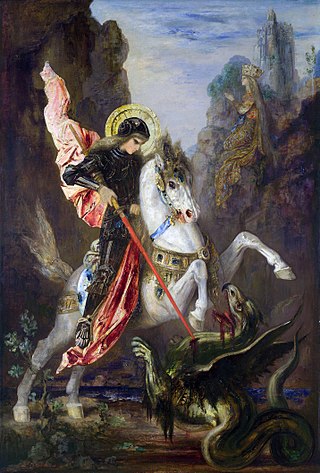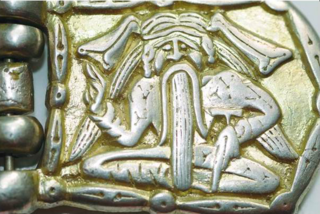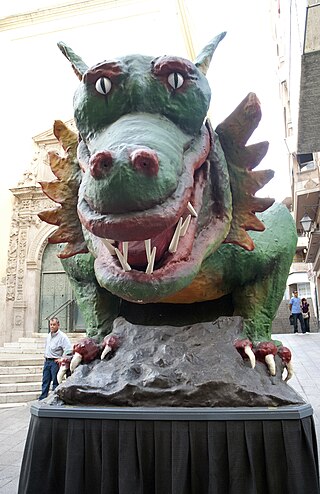
Christian mythology is the body of myths associated with Christianity. The term encompasses a broad variety of legends and narratives, especially those considered sacred narratives. Mythological themes and elements occur throughout Christian literature, including recurring myths such as ascending a mountain, the axis mundi, myths of combat, descent into the Underworld, accounts of a dying-and-rising god, a flood myth, stories about the founding of a tribe or city, and myths about great heroes of the past, paradises, and self-sacrifice.

A dragon is a magical legendary creature that appears in the folklore of multiple cultures worldwide. Beliefs about dragons vary considerably through regions, but dragons in Western cultures since the High Middle Ages have often been depicted as winged, horned, and capable of breathing fire. Dragons in eastern cultures are usually depicted as wingless, four-legged, serpentine creatures with above-average intelligence. Commonalities between dragons' traits are often a hybridization of feline, reptilian, mammalian, and avian features. Some scholars believe large extinct or migrating crocodiles bear the closest resemblance, especially when encountered in forested or swampy areas, and are most likely the template of modern Asian dragon imagery.

The Wild Hunt is a folklore motif occurring across various northern, western and eastern European cultures, appearing in the religions of the Germans, Celts, and Slavs. Wild Hunts typically involve a chase led by a mythological figure escorted by a ghostly or supernatural group of hunters engaged in pursuit. The leader of the hunt is often a named figure associated with Odin in Germanic legends, but may variously be a historical or legendary figure like Theodoric the Great, the Danish king Valdemar Atterdag, the dragon slayer Sigurd, the Welsh psychopomp Gwyn ap Nudd, biblical figures such as Herod, Cain, Gabriel, or the Devil, or an unidentified lost soul either male or female. The hunters are generally the souls of the dead or ghostly dogs, sometimes fairies, valkyries, or elves.

The European dragon is a legendary creature in folklore and mythology among the overlapping cultures of Europe.
Seneca mythology refers to the mythology of the Onödowáʼga:, one of the six nations of the Haudenosaunee from the northeastern United States and Canada.

The bogeyman is a mythical creature used by adults to frighten children into good behaviour. Bogeymen have no specific appearances and conceptions vary drastically by household and culture, but they are most commonly depicted as masculine or androgynous monsters that punish children for misbehaviour. The bogeyman, and conceptually similar monsters can be found in many cultures around the world. Bogeymen may target a specific act or general misbehaviour, depending on the purpose of invoking the figure, often on the basis of a warning from an authority figure to a child. The term is sometimes used as a non-specific personification of, or metonym for, terror, and sometimes the Devil.
In Catalan myth, Dip is an evil, black hellhound and emissary of the Devil, who sucks people's blood. Like other figures associated with demons in Catalan myth, he is lame in one leg. Dip is pictured on the escutcheon of Pratdip.

A hellhound is a mythological hound that embodies a guardian or a servant of hell, the devil, or the underworld. Hellhounds occur in mythologies around the world, with the best-known examples being Cerberus from Greek mythology, Garmr from Norse mythology, the black dogs of English folklore, and the fairy hounds of Celtic mythology. Physical characteristics vary, but they are commonly black, anomalously overgrown, supernaturally strong, and often have red eyes or are accompanied by flames.

A deal with the Devil is a cultural motif exemplified by the legend of Faust and the figure of Mephistopheles, as well as being elemental to many Christian traditions. According to traditional Christian belief about witchcraft, the pact is between a person and the Devil or another demon, trading a soul for diabolical favours, which vary by the tale, but tend to include youth, knowledge, wealth, fame and power.

Dragons play a significant role in Greek mythology. Though the Greek drakōn often differs from the modern Western conception of a dragon, it is both the etymological origin of the modern term and the source of many surviving Indo-European myths and legends about dragons.

Korean dragons are legendary creatures in Korean mythology and folklore. The appearance of the dragon reflects its relation to its East Asian counterparts, including the Chinese dragons.
In Catalan mythology an aloja, also known as dona d'aigua, goja or paitida, is a feminine being that lives in places with fresh water. These "water-women" are said to be able to turn into water blackbirds.

Hungarian mythology includes the myths, legends, folk tales, fairy tales and gods of the Hungarians, also known as the Magyarok.
In Catalan mythology, Comte Arnau is a legendary nobleman from Ripollès who, for his rapacious cruelty and lechery, is condemned to ride an undead horse for eternity while his flesh is devoured by flames. He is the subject of a classic traditional Catalan ballad. The legend has its origins in a popular song of the sixteenth century.

The Marraco is a dragon or frightening creature in Catalan myth in the city of Lleida. It possessed a mouth wide enough to swallow a human whole according to tales told to frighten children.

The mythologies in present-day Italy encompass the mythology of the Romans, Etruscans, and other peoples living in Italy, those ancient stories about divine or heroic beings that these particular cultures believed to be true and that often use supernatural events or characters to explain the nature of the universe and humanity.
Vietnamese mythology comprises folklore, national myths, legends, or fairy tales from the Vietnamese people with aspects of folk religion in Vietnam. Vietnamese folklore and oral traditions may have also been influenced by historical contact with neighbouring Tai-speaking populations, other Austroasiatic-speaking peoples, as well as with people from the region now known as Greater China.
The Slavic creation myth is a cosmogonic myth in Slavic mythology that explains how the world was created, who created it, and what principles guide it. This myth, in its Christianized form, survived until the nineteenth and twentieth century in various parts of the Slavdom in chronicles or folklore. In the Slavic mythology there are three versions of this myth: the first version is the so-called earth-diver myth, which intertwines two main motifs: the dualistic motif – the cooperation of God and the Devil is required to create the world, and the oceanic motif – the pre-existence water, where the seed of the Earth comes from; the second version speaks about the origin of the universe and the world from the Cosmic Egg and the World Tree; the third one about creation from a dismemberment of a primordial being.
Lower mythology is a sphere of mythological representations relating to characters who have no divine status, demons and spirits, as opposed to higher gods and the official cult. This opposition is particularly pronounced in world religions.











